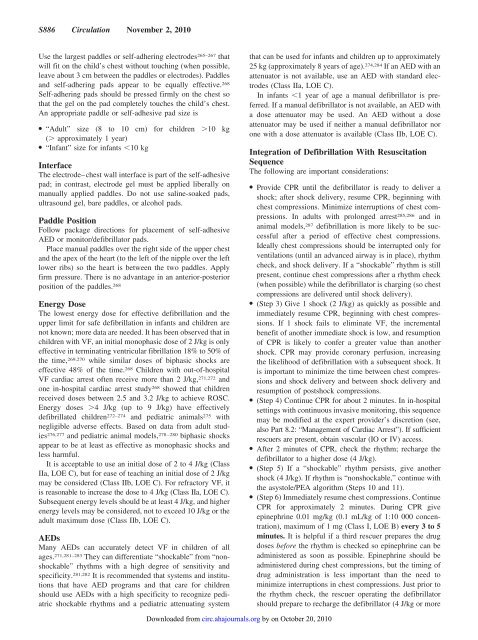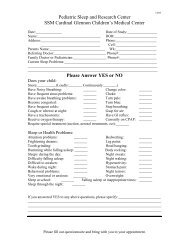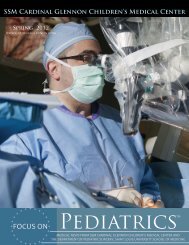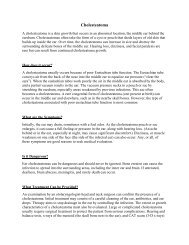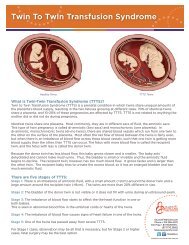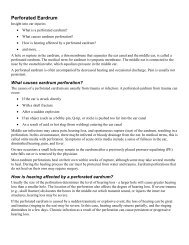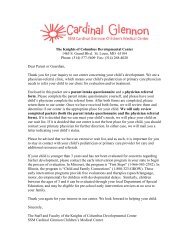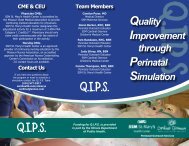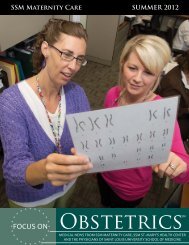pediatric-ALS-AHA-guidelines-circulation_11-2010 - SSM Cardinal ...
pediatric-ALS-AHA-guidelines-circulation_11-2010 - SSM Cardinal ...
pediatric-ALS-AHA-guidelines-circulation_11-2010 - SSM Cardinal ...
Create successful ePaper yourself
Turn your PDF publications into a flip-book with our unique Google optimized e-Paper software.
S886 Circulation November 2, <strong>2010</strong>Use the largest paddles or self-adhering electrodes 265–267 thatwill fit on the child’s chest without touching (when possible,leave about 3 cm between the paddles or electrodes). Paddlesand self-adhering pads appear to be equally effective. 268Self-adhering pads should be pressed firmly on the chest sothat the gel on the pad completely touches the child’s chest.An appropriate paddle or self-adhesive pad size is● “Adult” size (8 to 10 cm) for children 10 kg( approximately 1 year)● “Infant” size for infants 10 kgInterfaceThe electrode–chest wall interface is part of the self-adhesivepad; in contrast, electrode gel must be applied liberally onmanually applied paddles. Do not use saline-soaked pads,ultrasound gel, bare paddles, or alcohol pads.Paddle PositionFollow package directions for placement of self-adhesiveAED or monitor/defibrillator pads.Place manual paddles over the right side of the upper chestand the apex of the heart (to the left of the nipple over the leftlower ribs) so the heart is between the two paddles. Applyfirm pressure. There is no advantage in an anterior-posteriorposition of the paddles. 268Energy DoseThe lowest energy dose for effective defibrillation and theupper limit for safe defibrillation in infants and children arenot known; more data are needed. It has been observed that inchildren with VF, an initial monophasic dose of 2 J/kg is onlyeffective in terminating ventricular fibrillation 18% to 50% ofthe time, 269,270 while similar doses of biphasic shocks areeffective 48% of the time. 268 Children with out-of-hospitalVF cardiac arrest often receive more than 2 J/kg, 271,272 andone in-hospital cardiac arrest study 268 showed that childrenreceived doses between 2.5 and 3.2 J/kg to achieve ROSC.Energy doses 4 J/kg (up to 9 J/kg) have effectivelydefibrillated children 272–274 and <strong>pediatric</strong> animals 275 withnegligible adverse effects. Based on data from adult studies276,277 and <strong>pediatric</strong> animal models, 278–280 biphasic shocksappear to be at least as effective as monophasic shocks andless harmful.It is acceptable to use an initial dose of 2 to 4 J/kg (ClassIIa, LOE C), but for ease of teaching an initial dose of 2 J/kgmay be considered (Class IIb, LOE C). For refractory VF, itis reasonable to increase the dose to 4 J/kg (Class IIa, LOE C).Subsequent energy levels should be at least 4 J/kg, and higherenergy levels may be considered, not to exceed 10 J/kg or theadult maximum dose (Class IIb, LOE C).AEDsMany AEDs can accurately detect VF in children of allages. 271,281–283 They can differentiate “shockable” from “nonshockable”rhythms with a high degree of sensitivity andspecificity. 281,282 It is recommended that systems and institutionsthat have AED programs and that care for childrenshould use AEDs with a high specificity to recognize <strong>pediatric</strong>shockable rhythms and a <strong>pediatric</strong> attenuating systemthat can be used for infants and children up to approximately25 kg (approximately 8 years of age). 274,284 If an AED with anattenuator is not available, use an AED with standard electrodes(Class IIa, LOE C).In infants 1 year of age a manual defibrillator is preferred.If a manual defibrillator is not available, an AED witha dose attenuator may be used. An AED without a doseattenuator may be used if neither a manual defibrillator norone with a dose attenuator is available (Class IIb, LOE C).Integration of Defibrillation With ResuscitationSequenceThe following are important considerations:● Provide CPR until the defibrillator is ready to deliver ashock; after shock delivery, resume CPR, beginning withchest compressions. Minimize interruptions of chest compressions.In adults with prolonged arrest 285,286 and inanimal models, 287 defibrillation is more likely to be successfulafter a period of effective chest compressions.Ideally chest compressions should be interrupted only forventilations (until an advanced airway is in place), rhythmcheck, and shock delivery. If a “shockable” rhythm is stillpresent, continue chest compressions after a rhythm check(when possible) while the defibrillator is charging (so chestcompressions are delivered until shock delivery).● (Step 3) Give 1 shock (2 J/kg) as quickly as possible andimmediately resume CPR, beginning with chest compressions.If 1 shock fails to eliminate VF, the incrementalbenefit of another immediate shock is low, and resumptionof CPR is likely to confer a greater value than anothershock. CPR may provide coronary perfusion, increasingthe likelihood of defibrillation with a subsequent shock. Itis important to minimize the time between chest compressionsand shock delivery and between shock delivery andresumption of postshock compressions.● (Step 4) Continue CPR for about 2 minutes. In in-hospitalsettings with continuous invasive monitoring, this sequencemay be modified at the expert provider’s discretion (see,also Part 8.2: “Management of Cardiac Arrest”). If sufficientrescuers are present, obtain vascular (IO or IV) access.● After 2 minutes of CPR, check the rhythm; recharge thedefibrillator to a higher dose (4 J/kg).● (Step 5) If a “shockable” rhythm persists, give anothershock (4 J/kg). If rhythm is “nonshockable,” continue withthe asystole/PEA algorithm (Steps 10 and <strong>11</strong>).● (Step 6) Immediately resume chest compressions. ContinueCPR for approximately 2 minutes. During CPR giveepinephrine 0.01 mg/kg (0.1 mL/kg of 1:10 000 concentration),maximum of 1 mg (Class I, LOE B) every 3 to 5minutes. It is helpful if a third rescuer prepares the drugdoses before the rhythm is checked so epinephrine can beadministered as soon as possible. Epinephrine should beadministered during chest compressions, but the timing ofdrug administration is less important than the need tominimize interruptions in chest compressions. Just prior tothe rhythm check, the rescuer operating the defibrillatorshould prepare to recharge the defibrillator (4 J/kg or moreDownloaded from circ.ahajournals.org by on October 20, <strong>2010</strong>


